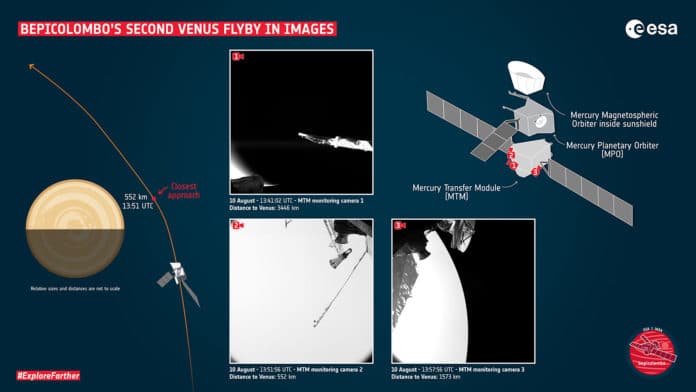On 9th August 2021, the ESA/NASA Solar Orbiter and BepiColombo spacecraft made a historic Venus flyby at a distance of 7995 km and 552 km from the planet’s surface. The spacecraft passes by the planet within 33 hours. In addition, they captured some unique images, videos, and data during the flyby.
The reaction wheels installed on both spacecraft maintain spacecraft attitude, keeping it pointing on course. When spacecraft flew past Venus, the reaction wheels felt the immense gravitational pull of the planet in the angular momentum.
The spacecraft also measured the accelerations, which were then recorded by the Italian Spring Accelerometer (ISA) onboard the BepiColombo MPO. The acceleration data was then translated into frequency so that humans can hear it. The resulting sound involves the effects of the planet’s gravity acting on the spacecraft structure, the response of the spacecraft to the rapid temperature changes, and the reaction wheels working hard to compensate for these effects.
What’s more, for the first time, the accelerometer recorded the tidal effects acting on the spacecraft on another planet. Scientists are now analyzing this data.
While traveling from nightside to dayside of planet, both spacecraft felt a rapid increase of heat. The JAXA Mercury Magnetospheric Orbiter (MMO), situated inside the sun-shield, recorded an increase of 110 degrees Celsius on one of its eight solar panels, from -100ºC to +10ºC. Within the spacecraft itself, only a rise of 2-3 degrees was observed, demonstrating the effectiveness of the insulation.
On the European Mercury Transfer Module, a temperature increase of 50 degrees was observed on the spacecraft radiator, while the Mercury Planetary Orbiter (MPO) recorded a change of about 20 degrees.
The magnetometer teams from both spacecraft report they saw the effects of the flyby in their data. The data offered a rare glimpse into the solar wind interaction with a planetary atmosphere. The audio captures low-frequency wind-like noises caused by the solar wind and its interaction with Venus.
In the days leading up to the Venus flyby, Solar Orbiter’s SoloHI imager caught the dramatic glare of the planet’s dayside. In the footage, we see Venus moving across the field of view from the left, while the Sun is off-camera to the upper right. The planet’s nightside, hidden from the Sun, appears as a dark semicircle surrounded by a bright crescent of light.
On the other hand, BepiColombo’s three monitoring cameras captured a series of black-and-white snapshots. You can see the complete set of images from the flyby in the Planetary Science Archive.
With the close encounter, MPO’s Mercury Radiometer and Thermal infrared Imaging Spectrometer (MERIS) could capture spectra of the Venus atmosphere while the planet filled its field of view.
